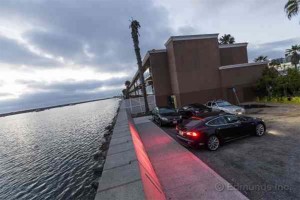A team of drivers has gone a long way – 3,331.9 miles, in fact – to disprove negative perceptions about electric vehicles, setting an all-time record along the way.
Driving a Tesla Model S from Redondo Beach, California to New York City in just 67 hours 21 minutes, they showed that battery cars aren’t necessarily slow, nor limited in range, and they demonstrated the potential for new quick charging technology, as well.
Dan Edmunds, the director of vehicle testing for website Edmunds.com, led expedition, paired up with the auto tracking service’s photo editor Kurt Niebuhr. Significantly, they made the trip on their own, without the sort of backup often used in record runs – including an earlier trip sponsored by Tesla itself meant to prove that a Model S really could drive coast-to-coast in reasonable time.
Tesla’s own effort had set the previous cross-country record for a battery-electric vehicle, or BEV, making the California to New York run in 76 hours 5 minutes.
(Tesla halts production as it retools plant to build new Model X battery SUV. Click Here for more.)
The start-up battery carmaker has been promoting its Model S as a vehicle that can break the EV paradigm. While most BEVs are limited to around 100 miles per charge – and typically requiring as much as eight hours or more to recharge – the most expensive version of the Model S, equipped with an 85 kilowatt-hour battery pack, can deliver almost 300 miles range.
Meanwhile, Tesla has been setting up a nationwide network of so-called Superchargers, 440-volt DC systems capable of giving a Model S an 80% recharge in a little more than 30 minutes.
(Tesla confirms plans for third, mainstream EV, the Model 3. For more, Click Here.)
The challenge for the Edmunds team was that they chose to take a cross-country route that hadn’t had its Supercharger network fully set up. That required the sort of strategy someone driving a conventional gasoline vehicle wouldn’t have to worry about.
They “filled” the battery at each charger with just enough juice to make it safely to the next Supercharger, sometimes arriving perilously close to running out of power.
On the positive side, the stops provided a bit more time to grab a bite to eat than they would have had at a regular gas pump.
There were no major stops, however, and sleeping was done in shifts while one of the pair assumed driving duties.
(“Tuner” company Saleen is planning a high-performance version of the Tesla Model S. Click Here for more.)
The biggest hassle, apparently, was having to wait in line for toll booths, a particular headache as they got nearer to their New York destination. Actual driving time came to 52 hours 41 minutes, with another 15 hours for charging and other delays – the typical wait at a Supercharger station coming to 38.3 minutes.
In the end, they managed to make the trip nearly nine hours faster than the previous Tesla factory team was able to pull off.
Some other interesting statistics: the pair averaged 63.2 mph along the way. And they used a total of 1.06 Megawatt-hours of electricity – about the equivalent of the energy in 30 gallons of gas.
Oh, and their total cost to charge up along the way? Zip, zero, nada. The Tesla Supercharger system is available at no charge to Tesla owners. To put that in comparison, even a high-mileage vehicle like the Toyota Prius would have used 60 to 70 gallons of fuel, running up a bill of perhaps $250. A gas-powered luxury vehicle or sports car more in line with the Tesla might have needed well over 100 gallons of gasoline.


